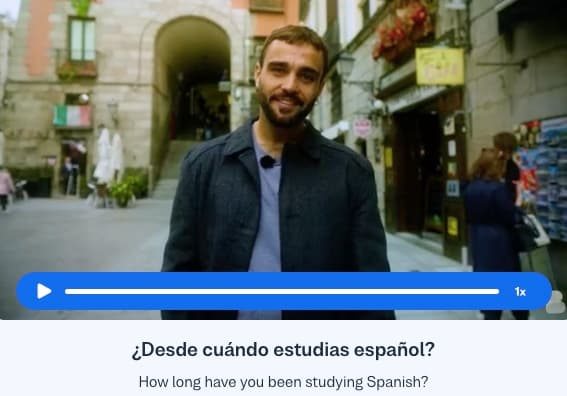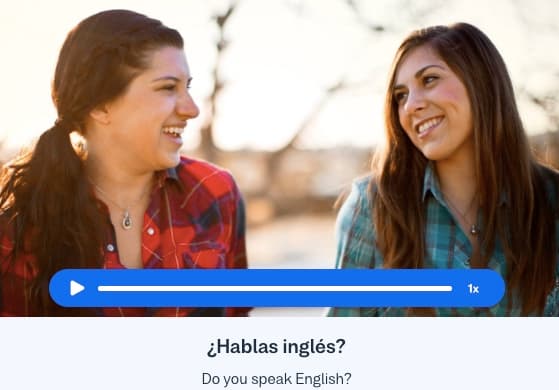I want to learn...
There’s no one best way to learn a new language. Everyone’s situation is different. Everyone learns differently. But there are some proven methods and principles that everyone should follow.
In this article, you’ll learn about five of the best ways to learn a new language.
1. Immerse yourself overseas
There’s no better way to learn a new language and culture than jumping in at the deep end and living overseas. And it’s never been easier. Study-abroad programs, working holiday visas, and digital nomad options mean there are few countries you can’t experience.
You can learn to speak like a local with the locals. And you can have a great time too. But it’s not all about learning a language. Research shows that studying overseas increases your language skills, confidence, and motivation. And that people who completed long study abroad programs develop personally and interculturally and have better career choices.
If you have the means, living overseas is one of the most worthwhile things you can do. Your language skills will go through the roof and you’ll develop as a person. Plus you’ll have an awesome time exploring new places and cultures.
2. Immerse yourself in your home country
Of course, living abroad isn’t an option for many people. It’s expensive. And if you have commitments at home, spending a year away is impossible. But there are ways to immerse yourself in a new language at home too.
Make friends with native speakers. Join language exchange groups, take part in events, and do your hobby with native speakers. If you live in a multicultural area, you can find people who speak your new language.
Go to restaurants and cafes to order in your new language. This is a great way to get practice. And the best thing is, you get immediate feedback (and delicious food). If the waiter doesn’t understand what you say, you know there's something wrong with the language you use. You can reflect and try again.
Consume content. Listen to podcasts while you’re cooking. Read books on the way to work. Watch movies on the weekend. All of these are great ways to immerse yourself in a language.
Use Busuu. Do online courses, get feedback from native speakers, and practice all four skills on your mobile device.
3. Forget being perfect
When learning a new language, it’s easy to fall into an accuracy-is-everything mindset. So you search for only the best words. And only speak when you know exactly what to say. We get it, no one wants to look stupid. But remember the goal of learning a language: To communicate.
You can communicate without being perfectly accurate. In fact, you can communicate by pointing and waving your hands around. Perfect grammar or vocabulary isn’t necessary to communicate. So it's a good idea to reframe your goals. It’s like my high school coach used to say: “Good enough is good enough.”
Think of it like this: To be good at a language you need to understand other people and they need to understand you. That’s it. You don’t need to be perfect. Perfectionism gets in the way of practice and stops you from hitting your goals.
Don’t worry about making mistakes or looking silly. Put yourself out there, practice, and communicate with as many people as possible. And you’ll see that always using the correct word or grammar doesn’t really matter.
4. Get tons of input
Let’s think about a reading activity in a traditional language class. The teacher gives you a text to read and some questions to answer. The text includes some grammar or vocabulary the teacher wants you to learn. It’s a challenging text. So as you read, you look up words in your dictionary and you try to understand new grammar structures. It's probably long so it takes ages. It could take a full lesson just to read one page.
Unfortunately, with this kind of learning you get very little input.
Here’s a better approach. You choose your own text (reading or listening) that isn’t too difficult. You choose the topic so it’s interesting. And you go through it without needing your dictionary. Because it’s fun and easy, you get through the content in no time. Then you start the next text. This is the best way to rack up as much input as possible.
You can build a positive cycle reading this way. Reading is fun and easy. You finish texts quickly. The positive feelings from this fun reading make you want to read more. The cycle keeps going around and you keep getting lots of quality input.
You could use graded readers, podcasts, or even TV shows. All that matters is that you get a lot of input that you can understand. And if you choose content you're interested in, you keep the cycle going and it’s so much easier to get a lot of input.
5. Balance the four strands of language learning
But input is just one part of learning a language. You also need to do meaningful output, fluency practice, and form-focused activities (like the traditional reading activity above).
Unfortunately, this is where many learners get language studying wrong. They spend most of their time learning grammar and vocabulary (form-focused activities).
They study the language. But they don’t practice using it.
The ratio of study to practice should be 3:1. This means you should spend around the same amount of time on each of the four strands. Let’s take a closer look at these key areas:
Comprehensible input. Comprehensible input is language you read or hear that’s just above your current level. It’s not too easy and it’s not too difficult. Plenty of research shows comprehensible input is one of the most important things when learning a language.
Meaningful output. Meaningful output is the language you produce to communicate and is key to mastering a new language. It’s not repeating sentences or doing pronunciation drills. For output to be meaningful, you need to be trying to convey a message. It allows you to see where you’re making mistakes because feedback from the person you're communicating with is immediate.
Fluency practice. It’s important to practice speaking, reading, and writing quickly. So set yourself a timer, forget being accurate, and practice being fast. One great example of fluency practice is 4/3/2 speaking. Set a timer and talk about a topic for 4 minutes. Next, do the same for 3 minutes. And then 2 minutes. This activity helps you eliminate pauses and hesitations in your speaking.
Form-focused learning. Form-focused learning is analyzing language features like pronunciation, grammar, and vocabulary. This is the studying part of your learning. This is the kind of learning you likely did in language class at schools: Remembering word lists, translating sentences, and analyzing grammar.
If you split your time evenly between these four areas, you’ll give yourself the best chance to hit your language goals.
AUTHOR

Barney Meekin
Newlanguages


